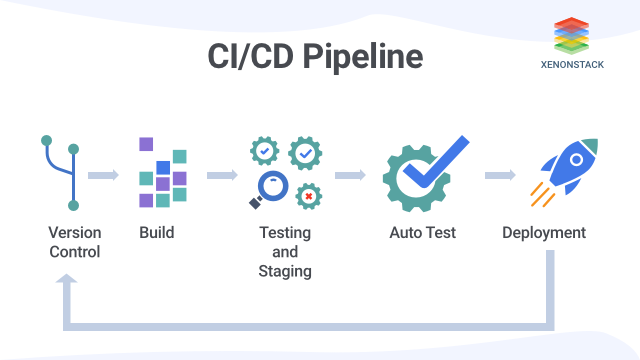How Continuous Integration and Continuous Delivery Works
Introduction to Continuous Integration and Delivery
CI/CD (Continuous Integration and Continuous Delivery) incorporate values, a set of operating principles, and a collection of practices that enable application development teams to deliver changes more reliably and regularly; this is also known as CI/CD pipeline. But what do the individual terms mean?A process in which, Modern software engineering Culture and Practices to develop software where the development and operation teams work hand in hand as one unit. Click to explore about, What is DevOps and it's Processes?
What is Continuous Integration (CI)?
Continuous integration is an approach in which developers merge their code into a shared repository several times a day. For verification of the integrated code, automated tests and builds are run for it.What is Continuous Delivery (CD)?
Continuous delivery is a strategy in which the development teams ensure the software is reliable to release at any time. On each commit, the software passes through the automated testing process. If it successfully passes the testing, and it is ready for release into production.What is CI/CD Pipeline?
CI is the short form for Continuous Integration, and CD is the short form for Continuous Delivery. CI/CD Pipeline is a crucial part of the modern DevOps environment. The pipeline is a deployable path that the software follows to its production with Continuous Integration and Continuous Delivery practices. It is a development lifecycle for software and includes the CI/CD pipeline, which has various stages or phases through which the software passes.
Version Control Phase
In this phase of the CI/CD pipeline, the developers' code have version control software or systems such as git, apache subversion, and more. It controls the commit history of the software code so that it may change if needed.Build Phase
This phase is the first phase of this pipeline system. Developers build their code, and then they pass their code through the version control system or software. After this, the code returns to the build phase and compilation.Unit Testing and Staging
When software reaches this stage, various tests are there on the software. One of the main tests is the Unit test, which test the units of software. After successful testing, the staging phase begins. As software pass the tests to reach here, it is ready to deploy into the staging process. Here, the software code is deploy to the staging environment/server. View the code and finalize here before the final test conduct on the software.Auto Testing Phase
After passing to the staging environment, another set of auto testing is for the software. If the software completes these tests and it is passes to the next phase/stage, the deployment phase.Deployment Phase
As the auto testing procedure is over, then it is passes to production. However, if any error occurs during the testing phase or the deployment phase, the software is passes to the development team's version control procedure and check the errors. If errors are there, then need to fix them. Other stages can repeate if necessary.CI/CD mechanisms helps to test server configuration, server image building, environment provisioning and the mixture of environments. Source: Infrastructure as Code in CI/CD Pipeline
What are the best Continuous Integration and D Tools?
Automate the CI/CD process to get the best results. Various Continuous Integration and Continuous Delivery tools help us automate the process precisely and with the least effort. These tools are mostly open-source and help with collaborative software development. Some of these tools are:
Jenkins
Jenkins is the most commonly used tool for the CI/CD process. It is one of the earliest and most powerful CI tools. It has various interfaces and inbuilt tools, which help us in the CI/CD process's automation. At first, it was introduced as a part of a project named Hudson, released in 2005. Then it was officially released as Jenkins in 2011. It has a vast plugin ecosystem, which helps in delivering the features that we need.
Circle CI
Circle CI is getting popular these days. It is becoming one of the best build platforms. It is a modern tool for the CI/CD process. One of its newest features is Circle CI Orbs. It has sharable code packages that help in setting the build pipeline easily and quickly.GitLab CI
It is a Continuous Integration tool. It is built into the GitLab, which is a web-based DevOps tool and provides a Git-repository manager, which helps in managing the git repositories. This integrate into GitLab software after being a standalone project and release in September 2015. Here, the CI/CD process is defined within a code repository. There are some tools named runners, which are used to complete the work. We can choose different executors while configuring runners like Docker, VirtualBox, and many more. It uses YAML configuration syntax to define the process in the repository.Buddy
Buddy is one of the newest and smartest CI/CD tools. This tool is for the developers and helps in lowering the entry threshold in DevOps. Initially, its name was meat! which was changed to Buddy in November 2015. Initially it was as a cloud-only service. It does not use YAML configuration, but it supports .yml files.GoCD
It is an open-source tool and helps the development teams in the Continuous Delivery and Continuous Integration process. Initially released with the name Cruise in 2007 by ThoughtWorks, it was renamed GoCD in 2010.Continuous Delivery processes to build, test, configure and ready to deploy from a build to the production environment at any time. Click to explore about, Continuous Delivery Best Practices
What is the CI/CD Process?
It is a process involving both continuous integration and continuous delivery. The process starts with continuous integration, and continuous delivery picks up where it ends. It involves a development approach named DevOps.
What are the benefits of CI/CD?
What all are the benefits of incorporating CI/CD in your business framework? Know the details below:- Easy to Debug and Change:It is easier to debug and change the codes when small pieces of code are continuously integrating. We can test these pieces while continuously integrating them with the code repository.
- Release and Delivery Speed Increases: With CI/CD, the speed of release and delivery is increased along with the development. Releases become more frequent and reliable.
- Increased Code Quality: The code's quality increases as the code can be tested every time we integrate it with the code repository. The development becomes secure and more reliable. Also, CI/CD pipeline automates the integration and testing work, and more time use to increasing the code quality.
- Reduces the Cost: CI/CD automates the development and testing process, reducing the effort of testing and integration. Reduce the errors with automation, and it saves the time and cost of the developers. This save time and cost to increase the code quality.
- Increased Flexibility: With CI/CD, the errors are found quickly, and the product can be released more frequently. The flexibility to add new features increases. With automation, one can adopt new changes quickly and reliably.
What are the challenges of Continuous Integration and Delivery?
Listed below are some common pitfalls one may experience while working with CI/CD:May Automate wrong Processes
To shift from traditional models to DevOps, the existing organizations need to go through a transition process, which can be a long and difficult one. This process can take months and even more if you don't follow the right transition steps. The steps to adopt CI/CD--
- The repetition frequency of the process.
- The dependencies involved in the process & delay produced by them.
- Length of the process.
- The urgency in process automation.
- If the process is prone to errors if not automated.
Empower your enterprise with CI/CD pipeline to minimize issues at deployment and faster production rate. Source: Infrastructure as Code Platform for Cloud-Native
Confusion between Continuous Deployment and Delivery
Many organizations fail to distinguish between continuous deployment and continuous delivery. They are two very different concepts. In the case of continuous deployment, the code repository changes passes through the pipeline, and if it is successful, deploy changes immediately to production. In Continuous Deployment, deployment to the production environment is successful without manual approval.Inadequate Coordination between CI and CD
Continuous Delivery (CD) is the next step for Continuous integration(CI). They are two different items. But the implementation of CI/CD takes the collaboration of these two. Not possible to automate collaboration and communication.Meaningful Dashboards and Metrics may be absent
In many cases, the scrum team may create a dashboard without proper progressive assessment. The team falls prey to the logical misconception that the given metrics must be important. The team may not know what to track and may follow the wrong metrics. Different members of a team may have different preferences. Some also prefer to use traffic indicators for the work. Some may not like the work that others have done. Creating meaningful and useful CI/CD dashboards may be tricky and extremely difficult, as some may not be satisfied with the work. Listening to everyone becomes difficult.Requires New Skillset
The process is complicate for some developers and testers working on traditional in-house software development techniques. It has two solutions: either re-training the employees for the automation process or hiring new people who know the processor training. Both of the solutions are a cost to the organization.Maintenance is not Easy
After the transition, maintenance is necessary to ensure that the pipeline is properly working and there are no automation processes. The bigger the organization, the difficult it is to maintain the pipelines for different services.
A platform that reduces the space between Dev that is Development Team and Ops that is Operation Team to reduce the systems development life cycle. Click to explore about, Continuous Delivery Pipeline on GCP
What are the best practices of Continuous Integration and Delivery?
There are some practices in the CI/CD process, which greatly enhance the performance of the process, and adhering to them can help avoid some common problems :
CI/CD only Deploy Production.
In the case of CI/CD, the failures are immediately visible, and the production is stopped until the cause of the failure is found and is corrected. It is an important mechanism and keeps further environments safe from the distrustful code. It is a process that is made solely for software development, integration, and delivery work, so it has advantages over other procedures, i.e., it is automated and hence faster.
The fastest tests should be the earliest to run.
Some tests are comparatively faster than others. We should run these tests early. Running the fastest tests first helps in finding the errors faster. It is essential to find errors in software development as soon as possible to prevent further problems.
Running the tests locally before committing to the CI/CD pipeline.
The developers should run the tests locally before committing or sharing them at the CI/CD pipeline or shared repository. This step is beneficial as it helps troubleshoot the software problems before sharing with others and is advantageous for the developer. Continuous Integratio
Keep the CI/CD pipelines fast
CI/CD pipelines are the core part of the CI/CD process; they are responsible for faster integration and faster delivery. We should find and apply methods to improve the speed and optimize the pipeline environment.

Managed services for Enterprises to facilitate Automated Security Alerts, Single Click Deployments and Monitoring Solutions. Managed DevOps Services and Solutions
Conclusion
CI/CD is among the best practices for the DevOps teams to implement using DevOps Assembly Line. Additionally, it's a unique methodology for the agile enterprise that facilitates the development team to achieve the business requirements, best code quality, and security because deployment steps are automated.
- Know here about the Role of Automated Testing in Agile Enterprise
- Discover more about DevOps Assembly Lines
Source: https://www.xenonstack.com/blog/continuous-integration-and-delivery
0 Response to "How Continuous Integration and Continuous Delivery Works"
Post a Comment